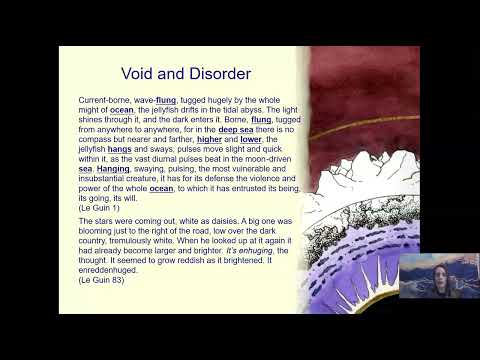 Speaker : Elizabeth Oakes
Speaker : Elizabeth Oakes
 Affiliation : Doctoral Researcher at University of Helsinki
Affiliation : Doctoral Researcher at University of Helsinki
Title : Void or Connection? Representations of Altered Consciousness in American Science Fiction 1960-1979: A Computational-Stylistic Corpus Analysis
Abstract : This paper discovers and describes two distinct styles of representing altered consciousness in a corpus of American science fiction published between 1960 and 1979 and demonstrates these styles’ relationship to common themes – void and, conversely, connection. A blended computational-stylistic methodology that facilitates a scalable approach to a corpus recontextualizes two well-studied subgenres of science fiction and offers new insights into the connections between style, theme, and cultural currents. It elucidates the impact representations of atypical minds had on speculation at a time when science fiction increasingly embraced diverse viewpoints.

 Long abstract
Long abstract
What can we learn about speculation by viewing the future through atypical mental perspectives? During the 1960s and 1970s science fiction began a process of increased diversification that continues today. Representations of altered consciousness, namely dreams, drug trips, and mental illness, became common. No longer merely a device to render villains abject, portraying altered consciousness allowed authors to explore different framings of social and cultural issues. In the science fiction of the 1960s and 1970s, an increasingly varied range of authors imagined an increasingly varied range of futures through the trope of altered consciousness. Reading science fiction through the lens of altered consciousness highlights how inclusion of diverse, atypical mental perspectives enabled speculation that influenced socio-cultural currents in ways that resonate even today.
Taking a quantitative, computational approach combined with a qualitative, stylistically framed reading, this paper discovers and describes two distinct styles of representing altered states of consciousness in a corpus of American science fiction published between 1960 and 1979. Analysis with the DocuScope and the Regressive Imagery Dictionary, content analysis programs that categorize the words of a text according to rhetorical and psychological paradigms respectively, reveals lexical aspects of style across the entire corpus. Then, traditional stylistic analysis relates the computational data to the thematics of select texts. This analysis identifies variables that distinguish different styles of representing altered consciousness as related to thematic specifics and facilitates construction of a model for cluster analysis. The corpus contains two stylistic clusters closely related to theme: the Void and Disorder Group and the Connection and Communication Group.
Mainly New Wave science fiction and texts embracing the stylistic experiments that characterized the New Wave comprise the Void and Disorder Group. New Wave science fiction often depicts man and nature at odds. The subgenre’s focus on inner space frequently results in projection of character-internal feelings of alienation and hopelessness onto the natural world. However, New Wave speculative fiction opens a window into the cultural resonances of mental illness. In this subgenre known for finely crafted styles, thematic nuance often arises from the linguistic specifics involved in representing such an altered state of consciousness. This group of texts echoes both the skepticism about psychiatry and the negative assessment of mental illness common in the 1960s and 1970s. Yet, the portrayal of altered states is more sympathetic than many contemporaneous depictions. Lexical analysis indicates that this group locates negativity in the vulnerability of the mentally ill rather than in the supposed dangers they pose. Although New Wave science fiction has been studied extensively in terms of its experimental style and its focus on the bleaker aspects of inner space, this study adds a new dimension in exploring the positive speculations that rise out of a negative portrayal of altered consciousness, speculations that perhaps shaped the period’s nascent awareness and destigmatization of mental illness.
Contemporaneously, a rising wave of feminist science fiction expressed resilience while imagining a better world for women. In this subgenre, depictions of altered consciousness often illuminate the desire to escape oppressive gender roles, comment on society’s perception of altered states, and offer alternate interpretations. At a time when pollution and environmental degradation were peak concerns and climate change was beginning to be recognized, a cross-section of feminist science fiction reimagined environmental embeddedness as an empowering source of fulfillment. Woman-authored novels comprise the core of the Connection and Communication group, though it contains several novels by men as well. In these novels, the style that equates altered consciousness with environmental embeddedness obviates binaries. While elements of both utopia and dystopia may be present, characters engage with the environment on its own terms in a productive struggle that vitiates these elements. Although the novels emphasize the harshness and apparent inimicalness of the environment, the characters do not take an oppositional attitude or experience the environment as an enemy. Thematically, understanding the environment and living closely with it empowers the self in the woman-authored novels in contrast to the corpus generally and its New Wave novels particularly. Although the environmentalism of individual authors has been researched, comparative eco-critical studies are rare compared to focus on themes of gender or feminist utopias and dystopias. This study addresses the gap by uncovering a positive and hopeful language of speculation underlying the theme of environmental embeddedness as a source of resilience and self-realization that characterizes the Connection and Communication Group.
A blended computational-stylistic methodology that facilitates a scalable approach to a corpus recontextualizes two well-studied subgenres of science fiction and offers new insights into the connections between style, theme, and cultural currents. It elucidates the impact representations of atypical minds had on speculation at a time when science fiction increasingly embraced diverse viewpoints.

